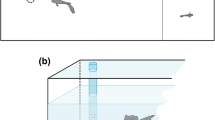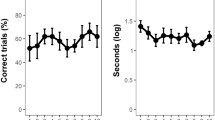Summary
-
1.
The gill cleaning movements ofLimulus occur in definite periods (bouts). The sequence of movements in a bout, and the movements themselves, are highly stereotyped.
-
2.
In a bout of gill cleaning the paired gill plates are adducted across the midline so that opposite gill plates can interact. The interaction consists of rhythmic flicking of the inner lobe of a gill plate between the book gill lamellae of the contralateral gill.
-
3.
Each bout of cleaning lasts for approximately one minute and can be divided into four basic phases: pairing, crossing over, lateral cleaning, and medial cleaning (Fig. 2).
-
4.
There are two distinct pairing arrangements of the gill plates during cleaning. During left leading (LL) cleaning all the gill plates are paired with an adjacent gill plate, except L1 and R5. During right leading (RL) cleaning, which is the mirror image of LL cleaning, all the gills are paired except for R1 and L5 (Fig. 3).
-
5.
Cleaning bouts are further organized into long-term patterns which last for hours (Fig. 4).
-
6.
There are four major muscle groups involved in gill cleaning. Muscles 48/115 adduct the gill plate across the midline; muscles 113/114 flick the inner lobe, and muscles 20 (remotor) and 22 (promotor) control the anterior-posterior position of the gill plate during cleaning. The patterns of activity of these muscles are reliably different during RL and LL cleaning (Fig. 5).
-
7.
Each abdominal ganglion controls the movements of a pair of gill plates. During a bout of cleaning one member of the pair is being cleaned (subprogram A) and the other is not being cleaned (subprogram B). It is suggested that there are higher-order interganglionic neurons which control the expression of either the RL or LL patterns of cleaning. This is accomplished by dictating which gill plate of a pair uses subprogram A and which subprogram B, for all five ganglia.
-
8.
It is concluded that a gill cleaning bout constitutes a moderately complex fixed action pattern, meeting the criteria of stereotypy within and between animals, intricacy of appendage movements, involvement of more than one effector system, and tendency to occur in its entirety in the absence of apparent stimuli (vacuum activity).
Similar content being viewed by others
Abbreviations
- CNS :
-
central nervous system
- L 1–5 :
-
left gill plates 1–5
- LL :
-
left leading pattern of gill cleaning
- R1–5 :
-
right gill plates 1–5
- RL :
-
right leading pattern of gill cleaning
References
Carlson, J.R., Bentley, D.R.: Ecdysis: neural orchestration of a complex behavioral performance. Science195, 1006–1008 (1977)
Davis, W.J.: The neural control of swimmeret beating in the lobster. J. Exp. Biol.50, 99–118 (1969)
Davis, W.J., Kennedy, D.: Organization of invertebrate motor systems. In: Handbook of physiology, Sect. 1, Vol. 1, Part 2. Geiger, S.R., Kandel, E.R., Brookhart, J.M., Mountcastle, V.B. (eds.), pp. 1023–1087. Bethesda: American Physiological Society 1977
Dorsett, D.A., Willows, A.O.D., Hoyle, G.: Neuronal basis of behavior inTritonia. IV. Central origin of a fixed action pattern. J. Neurobiol.4, 287–300 (1973)
Fourtner, C.R., Drewes, C.D., Pax, R.A.: Rhythmic outputs coordinating the respiratory movement of the gill plates ofLimulus polyphemus. Comp. Biochem. Physiol.38 A, 751–762 (1971)
Grillner, S.: Locomotion in vertebrates: central mechanisms and reflex interactions. Physiol. Rev.55, 304–347 (1975)
Hyde, I.H.: The nervous mechanism of respiratory movements inLimulus polyphemus. J. Morphol.9, 431–448 (1893)
Hyman, L.H.: The invertebrates: Platyhelminthes and Rhyncocoela. The acoelomate bilateria, Vol. II. New York: McGraw-Hill 1951
Jennings, J.B.: Symbiosis in the Turbellaria and their implications in studies on the evolution of parasitism. In: Symbiosis in the sea. Vernberg, W.B. (ed.). Columbia: South Carolina Press 1974
Koester, J., Mayeri, E., Liebeswar, G., Kandel, E.R.: Neural control of circulation inAplysia. II. Interneurons. J. Neurophysiol.37, 476–496 (1974)
Lankester, E.R., Benham, W.B.S., Beck, E.J.: On the muscular and endoskeletal systems ofLimulus andScorpio, with some notes on the generic characteristics of scorpions. II. Description of the muscular and endoskeletal systems ofLimulus. Trans. Zool. Soc. (London)11, 314–338 (1885)
Moffett, S.: Neuronal events underlying rhythmic behavior in invertebrates. Comp. Biochem. Physiol.57 A, 187–195 (1977)
Patten, W.: The evolution of vertebrates and their kin. Philadelphia: Blakiston 1912
Patten, W., Redenbaugh, W.A.: Studies onLimulus. II. The nervous system ofLimulus polyphemus. with observations upon the general anatomy. J. Morphol.16, 91–180 (1900)
Stein, P.S.: Intersegmental coordination of swimmeret motoneuron activity in crayfish. J. Neurophysiol.34, 310–318 (1971)
Truman, J.W., Sokolove, P.G.: Silk moth eclosion: hormonal triggering of a centrally programmed pattern of behavior. Science175, 1491–1493 (1972)
Watson, W.H. III: Long-term patterns of gill cleaning, ventilation and swimming inLimulus. J. Comp. Physiol.141, 77–85 (1980)
Watson, W.H. III, Wyse, G.A.: Coordination of heart and gill rhythms inLimulus. J. Comp. Physiol.124, 267–275 (1978)
Willows, A.O.D., Dorsett, D.A., Hoyle, G.: The neuronal basis of behavior inTritonia. III. Neuronal mechanism of a fixed action pattern. J. Neurobiol.4, 255–285 (1973)
Wyse, G.A.: Intracellular and extracellular motor neuron activity underlying rhythmic respiration inLimulus. J. Comp. Physiol.81, 259–276 (1972)
Wyse, G.A., Page, C.H.: Sensory and central nervous control of gill ventilation inLimulus. Fed. Proc.35, 2007–2012 (1976)
Wyse, G.A., Sanes, D.H., Watson, W.H. III: Central neural motor programs underlying short- and long-term patterns ofLimulus respiratory activity. J. Comp. Physiol.141, 87–92 (1980)
Author information
Authors and Affiliations
Additional information
This work was supported by PHS Grant NS 08869 to Gordon A. Wyse, a Grass Fellowship in Neurophysiology to Winsor H. Watson III, an allocation from the University of Massachusetts Computer Center, and a CURF grant from the University of New Hampshire. It is based on part of a dissertation submitted by Winsor Watson in partial fulfillment of the requirements for the degree of Doctor of Philosophy at the University of Massachusetts, Amherst. I wish to thank Dr. John Roberts, Dr. Margaret Anderson-Olivo and Dr. Gordon A. Wyse for their advice and critical reading of the manuscript, Louise O'Gorman, Hilda Greenbaum, George Drake and Paul Fachada for technical assistance, and Suzanne Lucas, Steve Zottoli and Marv Freadman for their support and encouragement. I am especially grateful to Gordon Wyse for his teaching, expertise, insight, and personal friendship throughout the duration of this study.
Rights and permissions
About this article
Cite this article
Watson, W.H. Limulus gill cleaning behavior. J. Comp. Physiol. 141, 67–75 (1980). https://doi.org/10.1007/BF00611879
Accepted:
Issue Date:
DOI: https://doi.org/10.1007/BF00611879




